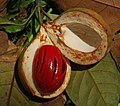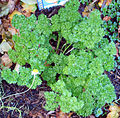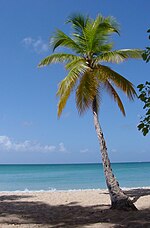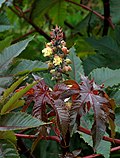Flowering plants are plants that bear flowers and fruits, and form the clade Angiospermae (/ˌændʒiəˈspərmiː/). The term 'angiosperm' is derived from the...
80 KB (6,327 words) - 01:04, 3 January 2025
genetic structure of nonclonal plant populations. Christian Konrad Sprengel (1793) studied the reproduction of flowering plants and for the first time it was...
29 KB (2,959 words) - 08:41, 9 December 2024
reproduction of flowering plants, the first is the timing of flowering and the other is the size or number of flowers produced. Often plant species have...
26 KB (3,245 words) - 02:29, 28 September 2024
history of flowering plants records the development of flowers and other distinctive structures of the angiosperms, now the dominant group of plants on land...
27 KB (2,890 words) - 22:22, 26 September 2024
included only flowering plants possessing seeds enclosed in capsules, distinguished from his Gymnospermae, which were flowering plants with achenial or...
13 KB (1,568 words) - 12:24, 28 November 2024
liverworts, mosses, lycophytes, ferns, conifers and other gymnosperms, and flowering plants). A definition based on genomes includes the Viridiplantae, along with...
95 KB (8,073 words) - 13:56, 24 December 2024
Botany (redirect from Plant biology)
000 species of land plants, including some 391,000 species of vascular plants (of which approximately 369,000 are flowering plants) and approximately 20...
137 KB (14,805 words) - 19:01, 3 January 2025
Hermaphrodite (redirect from Hermaphroditic plant)
known hermaphroditic species among mammals or birds. About 94% of flowering plant species are either hermaphroditic (all flowers produce both male and...
52 KB (5,148 words) - 21:39, 5 January 2025
Sexual reproduction (redirect from Sexual reproduction in flowering plants)
angiosperms have as few as three cells in each pollen grain. Flowering plants are the dominant plant form on land: 168, 173 and they reproduce either sexually...
39 KB (4,831 words) - 09:42, 27 November 2024
A biennial plant is a flowering plant that, generally in a temperate climate, takes two years to complete its biological life cycle. In its first year...
5 KB (599 words) - 05:48, 27 May 2024
parasitic plants in approximately 20 families of flowering plants are known. There is a wide range of effects that may occur to a host plant due to the...
29 KB (3,376 words) - 17:42, 4 January 2025
bryophylla is the highest flowering plant in the world, occurring as high as 6,180 m (20,280 ft). To survive, alpine plants are adapted to the conditions...
22 KB (2,561 words) - 22:02, 14 April 2024
Perennial (redirect from Perennial plant)
exceeding two years in the botanical world. Perennials (especially small flowering plants) that grow and bloom over the spring and summer, die back every autumn...
23 KB (2,728 words) - 06:09, 27 October 2024
in animal evolution but, with plants, it is often overlooked because many plants are hermaphrodites. Flowering plants show many characteristics that...
12 KB (1,590 words) - 12:54, 8 January 2025
Coevolution (redirect from Insect-flowering plant coevolution)
between flowering plants and insects in On the Origin of Species (1859). Although he did not use the word coevolution, he suggested how plants and insects...
49 KB (5,377 words) - 07:49, 8 January 2025
plants, such as wood formation. Biennial plant – Flowering plant that takes two years to complete its biological life cycle Perennial plant – Plant that...
13 KB (1,389 words) - 04:00, 10 October 2024
Dicotyledon (redirect from Dicotyledonous Plants)
more rarely, dicotyls), are one of the two groups into which all the flowering plants (angiosperms) were formerly divided. The name refers to one of the...
14 KB (784 words) - 08:32, 22 September 2024
division of plants, with upwards of 400,000 species. For two-dimensional area, the largest known clonal flowering plant, and indeed largest plant and organism...
17 KB (1,856 words) - 04:04, 17 November 2024
Rose (redirect from Rosa (plant))
A rose is either a woody perennial flowering plant of the genus Rosa (/ˈroʊzə/), in the family Rosaceae (/roʊˈzeɪsiːˌiː/), or the flower it bears. There...
34 KB (3,668 words) - 19:53, 7 January 2025
Sex (redirect from Sex in plants)
development of the embryonic plant. The flowers of flowering plants contain their sexual organs. Most flowering plants are hermaphroditic, with both...
66 KB (7,727 words) - 21:18, 1 December 2024
Spikenard (redirect from Nardin (plant))
amber-colored essential oil derived from Nardostachys jatamansi, a flowering plant in the honeysuckle family which grows in the Himalayas of Nepal, China...
14 KB (1,386 words) - 00:30, 26 December 2024
Arecaceae (redirect from Palm (plant))
of perennial, flowering plants in the monocot order Arecales. Their growth form can be climbers, shrubs, tree-like and stemless plants, all commonly known...
61 KB (6,119 words) - 22:06, 20 December 2024
Monstera deliciosa (redirect from Fruit Salad Plant)
Monstera deliciosa, the Swiss cheese plant or split-leaf philodendron is a species of flowering plant native to tropical forests of southern Mexico, south...
16 KB (1,895 words) - 01:14, 20 December 2024
Agave americana (redirect from Century Plant)
Agave americana, commonly known as the century plant, maguey, or American aloe, is a flowering plant species belonging to the family Asparagaceae. It...
20 KB (1,697 words) - 21:08, 18 November 2024
Pyrogenic flowering is the fire-adapted trait in plants that is defined by an increase or a peak in flowering after a fire event. Pyrogenic flowering allows...
8 KB (832 words) - 03:07, 11 November 2023
Fertilisation (section Flowering plants)
through the pollen tube to the ovule where the egg is fertilised. In flowering plants, two sperm cells are released from the pollen tube, and a second fertilisation...
46 KB (5,246 words) - 01:42, 28 December 2024
Swiss cheese plant in Wiktionary, the free dictionary. Swiss cheese plant may refer to: Monstera deliciosa, a species of flowering plant native to tropical...
381 bytes (94 words) - 21:28, 21 October 2024
Acanthus is a genus of about 30 species of flowering plants in the family Acanthaceae, native to tropical and warm temperate regions, with the highest...
9 KB (782 words) - 17:30, 8 January 2025
Ricinus (redirect from Castor bean plant)
Ricinus communis, the castor bean or castor oil plant, is a species of perennial flowering plant in the spurge family, Euphorbiaceae. It is the sole species...
32 KB (3,686 words) - 00:35, 19 October 2024

























